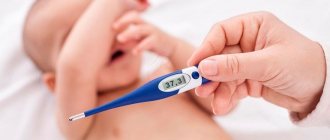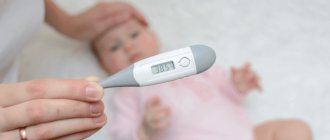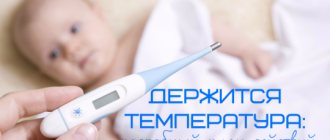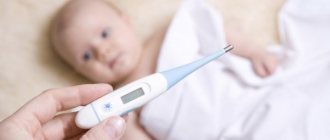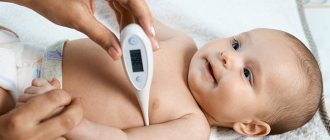When babies have a fever, parents are very worried, as they often do not understand what the reason is. However, daily fluctuations in newborns are normal, because their thermoregulation system is not yet fully functioning. Temperatures in the morning can be much lower than in the evening, this will probably depend on the ambient temperature. It is important to know how to determine a child’s temperature without a thermometer, and what the fluctuations may be.
Taking a baby's temperature
How does a child regulate temperature?
Body temperature is a measure of the body's ability to produce and eliminate heat. The body is very efficient at maintaining it within safe limits, even if external conditions change greatly.
The human body has mechanisms for thermoregulation by which the body loses or gains heat to maintain balance. The brain (specifically the hypothalamus) is responsible for thermoregulation. It receives information from various parts of the body and transmits corresponding impulses, including:
- blood vessels dilate when it is too hot to transfer excess heat to the surface of the skin;
- constrict blood vessels, reducing blood flow to the skin to retain heat.
In addition, at high temperatures, sweating begins, and at low temperatures, rapid muscle contractions (trembling) begin.
In newborns, the thermoregulatory system has its own characteristics. It is not used in the intrauterine stage, since the fetus is not subject to temperature fluctuations, and during pregnancy it produces approximately 2 times more heat than an adult. A significant part of this heat is dissipated in the mother's body.
Important! The initial test of cold for a person occurs at birth, at which time his thermoregulatory system begins to work for the first time.
The newborn produces heat primarily through chemical thermogenesis. Chilling, which is the main way children and adults produce heat, is not possible in newborns. They have a special and very effective way of thermoregulation - by metabolizing brown fat (a special fatty tissue located in different parts of the body and having a high ability to generate heat through chemical reactions). It usually disappears by the third month of life.
At what temperature should antipyretic drugs be given?
Newborns have imperfect thermoregulation mechanisms. Body temperature depends on the environment, clothing, and air humidity. Overheating and wrapping often lead to the thermometer readings showing values higher than normal. In hot weather, if you are in a stuffy room, or if the child is dressed too warmly, the temperature may rise to 37.5 - 37.9 degrees. In this case, no antipyretic medications are required - you need to exclude the source of overheating and take another measurement after 20 - 30 minutes.
It is important to understand that age-related temperature norms differ for infants and adults. Up to 1 year of life, indicators up to 37.5 are considered normal, provided that the child is alert, active, eats well, and has no problems with bowel movements or urination. Unreasonable use of drugs only harms a healthy child.
If the temperature rises to 38 degrees or higher, it is advisable to call a doctor to objectively assess the baby’s condition and prescribe medications if necessary. For viral and bacterial infections, it is not recommended to give antipyretic medications at temperatures of 38 - 38.2 degrees. By raising the temperature, the child’s body activates the immune system and fights pathogens, so taking medications is justified only if there is a risk of complications.
Antipyretic drugs are needed in the following cases:
- Temperature rises to 38.5 degrees and above. With such indicators, the respiratory system of newborn children suffers, and there is a load on the heart, blood vessels, and nervous system. The risk of febrile seizures, manifested by loss of consciousness and twitching of the limbs, increases;
- At a temperature of more than 38 degrees, if there is pallor or excessive redness of the skin, the child is lethargic, capricious, and refuses to eat. Such symptoms indicate that the baby has begun to become intoxicated, and the body needs help.
Normal temperature readings for newborns
According to various studies, the normal temperature of an adult should be 36.6-37.2°C. However, this rule does not apply to infants. Normal temperature readings for it are 36-38°C, depending on the measurement method. They can fluctuate throughout the day (usually lower in the morning and higher in the evening) and can increase if the baby, for example, cries or breastfeeds intensely.
Temperature norms for children
This is the norm
All children are born with an immature nervous and immune system, as well as insufficient function of the hypothalamus and thyroid gland. Therefore, it is important to know whether hyperthermia with a value of 37℃ in an infant is normal or is it a manifestation of some disease.
It has been established that in children 2, 3, 4, 5 or 6 months old, the temperature normally ranges from 36℃ to 37.5℃ and not higher.
Moreover, it depends on many factors, including the baby’s well-being, the ambient temperature, and the location of temperature measurement: in the elbow, armpit, mouth, forehead, rectum. Temperature in a child depending on age, measured in the armpit
| Age | Upper normal temperature range |
| 2 months | 37,5℃ |
| 3 months | 37,4℃ |
| 4 months | 37,4℃ |
| 5 months | 37,2℃ |
| 6 months | 37,1℃ |
The data is given for orientation purposes - for each specific child’s body, the normal temperature indicator may differ, and significantly.
The lower limit of normal for newborns and infants is considered to be a temperature of 35.5℃. It may be lower in the postpartum period due to cold stress, as the baby in the womb is accustomed to higher hyperthermia.
Low temperature is also observed after illness, with hypothermia. It can also occur in diseases such as chronic bronchitis, diseases of the brain, thyroid gland, internal bleeding or poisoning.
Reasons for rising and falling temperatures
A temperature value above 38°C is considered elevated. It is necessary not only to know how to understand that a newborn has a temperature, but also the reasons for this phenomenon. It may increase as a result of the following factors:
- Hyperthermia associated with environmental conditions such as excessive shelter, proximity to heat sources, or high air temperature;
Important! If overheating occurs, immediately remove the infant from the hot environment and monitor for a rapid and spontaneous drop in temperature.
- Reaction to vaccinations. In many infants, vaccine injections cause various reactions in the body, including a short-term increase in temperature above 38°C;
- A completely unformed thermoregulation system;
- During teething, the temperature can rise to 39°C. However, this condition does not last long. Additional signs are restlessness, crying, poor sleep, excessive salivation. The gum above the erupting tooth is red and swollen, painful and itchy.
- Conditions that require increased energy expenditure, for example, breastfeeding or active play.
Causes of increased temperature associated with pathological processes in the body:
- The most common cause is infections of the upper and lower respiratory tract: acute respiratory infections (colds), rhinitis, pharyngitis, laryngitis, bronchitis, pneumonia and otitis media. These are usually infections caused by viruses;
- Infectious diseases of the urinary tract;
- Gastrointestinal tract infections;
- Constipation that does not stop for a long time.
Reduced temperature values are considered to be values less than 36°C (rectal measurement). Infants lose heat much faster than adults, so hypothermia is especially dangerous for them.
Reduced temperature values
Important! When the temperature drops below 36°C, the heart, nervous system and other organs cannot function normally.
Reasons for low temperature:
- A transient decrease in temperature in newborns during the first hours of life during adaptation to new conditions;
- Finding thermoregulatory processes in the formation stage;
- Exposure to low temperatures for a long time, resulting in hypothermia;
Important! It is very easy for a newborn to become hypothermic if he is not properly dressed, or if he is in a draft or comes into contact with cold surfaces.
- As a result of treatment with antipyretics;
- When using excessive doses of vasoconstrictor drugs;
- Very rarely, the temperature drops during severe infections, such as meningitis and sepsis;
- During sleep and after waking up, as a rule, temperature values are lower than during wakefulness.
Reasons for temperature rise above normal
In the case when a 2-month-old baby experiences an increase in temperature above the indicated indicators, the following reasons could provoke such changes:
- excessively tight swaddling or clothes that are too warm and incompatible with the temperature of the room or air where the baby is located;
- keeping a 2-month-old baby in the sun for a long time;
- stool disorders - constipation provokes temperature changes;
- changes in the baby's drinking regime. If the body does not receive enough fluid, the sweating process is disrupted, and this directly affects the cooling of the body;
- It may be too early to talk about the eruption of the first teeth, but there are cases where at the age of two months a child’s gums begin to swell, which also affects the change in temperature;
- Excessive stimulation caused by constant crying, laughing, screaming or hot baths can cause a temperature above normal.
Each of the above reasons is the basis for a change in body temperature in a child at 2 months above normal. First of all, you should ensure the normal condition of the baby by dressing him in comfortable clothes that are appropriate for the atmosphere or weather.
Regularly give the child the amount of liquid that will be sufficient for a small body. To reduce the painful syndrome in case of teething, you can use pain-relieving gels for babies, which help relieve discomfort, which stabilizes the baby’s temperature.
Signs of temperature deviation from normal
Determining the exact temperature of the baby is done using a thermometer. There are 4 measuring methods:
- insert a thermometer into the anus;
- put it in your mouth;
- holding a thermometer under your arm;
- using an ear thermometer.
Ear thermometer
For infants, measuring temperature through the mouth is problematic, and under the armpits is not a very accurate method. The best solution is to measure the temperature through the anus or with an ear thermometer.
There are external signs of how to know that a newborn has a fever:
- With hyperthermia, blood vessels dilate, blood flow to the skin increases, and the skin becomes red;
- The baby is breathing rapidly;
- There may be increased sweating, especially in the neck area;
- Lack of appetite;
- The color of urine becomes brighter;
- The baby is irritable, cries and sleeps poorly.
How to understand that your child has a low temperature:
- The baby's skin is pale, moist, and may be covered with spots;
- The baby becomes lethargic and does not suck the breast or bottle well;
- Breathing quickens;
- Hands and feet become cold.
Methods for determining a baby’s temperature without a thermometer are approximate. It is difficult to figure out exactly what the baby’s temperature is with their help. The traditional method is to touch the baby's forehead or back of the neck with your lips. The back of the hand is not as sensitive to touch.
Temperature measurement with the touch of your palm
How to measure a child's temperature above 39°C without a thermometer? You can be guided by external symptoms. With such indicators, the baby’s sweating stops, and the mucous membrane of the eyes turns red.
How is this temperature treated?
Since the baby’s temperature of 37℃ is within normal limits, there is no need to treat the child. There is no need to use antibiotics or knock it down in various ways if there are no symptoms of the disease and, especially, without direct instructions from the doctor to do so.
But if you suspect infections, acute respiratory viral infections, acute respiratory infections, then even at a temperature of 37℃ you need to call a doctor. If a child has a stomach ache, a headache, cold hands and feet, convulsions appear, or wheezing is heard, then urgent medical attention is needed, regardless of whether you find it during the day, in the evening, or at night.
Do I need to give antipyretics?
At a temperature of 37 ℃, antipyretics based on paracetamol and ibuprofen are not necessary. But if the temperature of a child from 2 to 6 months has risen above 38 ℃, then, if prescribed by a doctor, you can use antipyretic drugs such as Nurofen, Ibuklin Junior, Ibufen, Panadol, Paracetamol, Cefekon. These medications are produced in the form of suspensions, tablets, and rectal suppositories. To treat a child, suspensions and rectal suppositories are usually used.
When you need help
Moderate fever (low-grade fever) does not require medication. You can apply cool compresses to the baby's forehead and neck, and also wrap his calves with a damp towel (necessarily soaked in water at room temperature).
Increased temperature has its positive sides. It is a symptom of the body's protective response. A little heat speeds up the metabolism, which stimulates the formation of antibodies.
Cold compress on forehead
Important! A prolonged increase in temperature causes the body to need large amounts of water, oxygen and energy. Consequently, it provokes dehydration and exhaustion.
It is necessary to call for medical help in the following cases:
- febrile seizures (the body's reaction to a rapidly rising temperature);
- the child cries desperately, especially when hugged;
- vomiting and diarrhea appeared;
- baby is sleepy and weak;
- there are disturbances of consciousness;
- red spots are visible on the skin;
- The baby's urine is dark yellow, he does not drool, he cries without tears - these may be signs of dehydration.
In general, children are less able to regulate their body temperature than adults. Therefore, they are more sensitive to external conditions. Heat and hypothermia are equally harmful. Parents should ensure the correct balance of temperatures, monitor the baby and, if there are alarming symptoms, consult a doctor in a timely manner.
Recommended antipyretics for children under one year of age
Antipyretic drugs for newborns differ in the active substance. For babies, suppositories, syrups, and suspensions based on paracetomol are more often used; from 3 months, medications with Nurofen are allowed.
The most common means:
- Rectal suppositories based on paracetomol. From 1 month, Panadol, Tsefekon D, Efferalgan are allowed. For children aged 1-3 months, a dosage of 50 mg is used (only Cefekon D is suitable), a child aged 3-12 months needs 100 mg suppositories;
- Liquid preparations with paracetamol. Suspensions “Panadol”, “Children’s paracetomol”, syrups “Efferalgan”, “Maxicold”. Medicines are prescribed at the rate of 10-15 mg/kg of the child’s body weight per dose. Of the presented antipyretic drugs, only Efferalgan is allowed for newborns from 1 month, the rest - from 3 months;
- Rectal suppositories with ibuprofen. Suppositories "Nurofen" are allowed from 3 months of a child's life. Each suppository contains 60 mg of ibuprofen. For a newborn weighing 6-8 kg, half the dose is given, for a child weighing up to 12 kg - a whole suppository;
- Suspension "Nurofen" (based on ibuprofen). This antipyretic drug is approved for use in newborns over 3 months weighing more than 5 kg;
- Homeopathic rectal suppositories "Viburkol". Suitable for combination therapy together with the main antipyretic drug. They help more effectively eliminate unpleasant symptoms during teething and ARVI. Can be used from birth.
Do not exceed age and daily dosages. If you need to use an antipyretic drug more than 4 times a day, alternate the drugs with paracetamol and ibuprofen, and change the dosage forms themselves. For example, if 3 hours after using Cefekon D suppositories the temperature rises again to high levels, use Nurofen syrup. Remember that you can alternate medications only after 3 months of life. In any case, try to minimize the use of drugs, since they place a serious burden on the newborn’s body.

